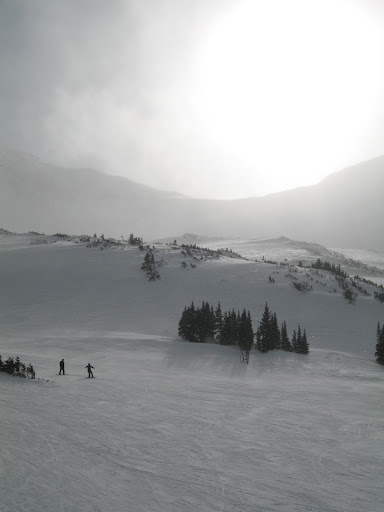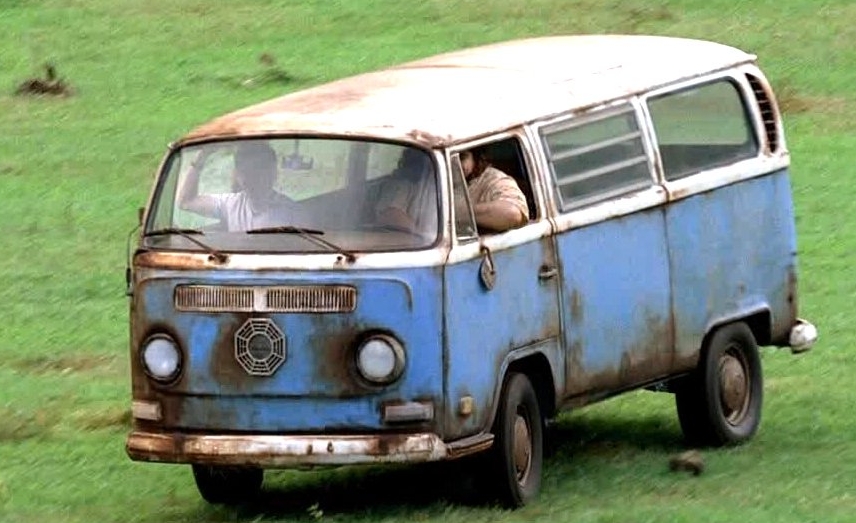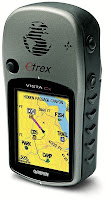
When the day was over, I had been asked this by at least four separate individuals. And to think that I had never heard of this trick before this week. Unfortunately it didn't help, and I needed a bigger metaphorical hammer to get my van moving in the snow again.
The spring snow storms have been continuing here in Colorado, so I decided to venture up to
Loveland Ski area and sleep in the
Westfalia last night. The anticipation and excitation built within me during the last hours of work on Friday, since at least a foot of snow was predicted to fall overnight with similar amounts throughout Saturday. My plan was beautiful. I would drive my souped up van to the ski area, sleep blissfully in propane fired warmth, and awake to a foot of snow and first chair while all the other suckers in Colorado battled the elements and each other on I-70 to make it up to the mountains.
The plan began great too. I made it up to
Loveland quickly with favorable road conditions, but then I faced the issue of where to park the van over night. If I parked in the middle of the lot, I risked getting asked to move by plow trucks. If I parked at the exit on the side pull-off, I risked getting plowed in and having to listen to 18 wheelers drive within 15 feet of my bed all night. So I opted to park next to the snow cat operators trucks at the edge of the
Loveland parking lot near the maintenance building. I would blend in with them and wake up early to gobs of snow and the best skiing of my life- a tremendous plan. I spent the evening chatting on the phone, watching a movie on my laptop, and drinking hot chocolate with Bailey's. I have to say that it was all quite civilized up to that point when I turned in at midnight to catch some
Z's.
I discovered that there are some serious issues with camping in your van in a ski area parking lot and that they are compounded when it is snowing out and you are parked next to the maintenance shed. First off, the snow cats like to go out and groom for a while and then return to the shed for a while. And when they do, their engines idle loudly and their ultra bright lights illuminate the entire area. And for some reason, they go out on missions for a while and then return, and they do this several times over the course of the night. Of course, I was paranoid that they would discover the
imposter in their parking lot and they would kick me out. I don't like snow cats quite as much any more. Second, guys who operate plows must really love their jobs, because they don't just plow a row once. They do it over and over and over again. And they don't seem to mind plowing snow right up to parked cars. Maybe the pull off parking spot wouldn't have been so bad after all. Finally,
Loveland and
CDOT like to blast for avalanches early in the morning. There's nothing quite like explosive charges to get your day going.
With all the racket and my paranoia, I probably got about 3 hours of sleep between midnight and my alarm at 7am. To top things off, the propane ran out some time during my slumber, so I awoke to freezing conditions inside the van and the inability to make coffee and toast in the van. Suddenly, things weren't quite so civilized any more. No problem, I thought. I will start the van to warm things up, get my ski clothes on, grab breakfast in the lodge, and blast through feet of fresh powder. Not so fast sonny. The forecast was a little optimistic in terms of snow accumulations. I would say that there was 6-8" of fresh snow, which was still good, but not the blizzard I had hoped for. Alright, turn the key to start your wonderful new
Zetec engine-
rrrrr,
rrrrr,
rrrrr. Ah crap, did I mention that the only piece of the van that I didn't replace during the engine conversion was the starter and that it started having "issues" with the solenoid not engaging the gear teeth last week? When I talked to Brady at
Bostig on Wednesday, guess what he asked me? "Did you hit it with a hammer?" So on Tuesday, I crawled under the van, tapped the starter with a hammer, played with the gear shifter position, and got it started. It started without issue the rest of the week, so I thought I was in the clear. Apparently not.
SUVs, trucks, and
Suburus began to pour into the parking lot and now I had to figure out how to start my van- crap, definitely not civilized. All of these Front-Range-get-up-in-the-dark-to-drive-I70-suckers were going to beat me to the fresh snow and I was going to be stuck working on my van one more weekend. At that point, I began to get a tad frustrated. Lack of sleep, hunger, cold, and a failed plan do not make a happy Pat. I donned my cold ski clothes, climbed under the van in the snow, and did my best to hit the starter with a hammer.
Rrrrr,
rrrrr,
rrrrr- still no dice. Screw it, AAA will bail me out later in the day if worse comes to worst, I'm going skiing. So I spent the morning
telemarking through some fantastic powder conditions. The snow wasn't particularly deep, but it was a great consistency, the mountain wasn't too crowded, and I skied really well.
Loveland is a really cool place to be on a powder day, but that day can only last so long before exhaustion sets in and it's time to head home.
I wandered back to the van determined to get it started by hitting it with a hammer. I struggled from every position imaginable, but it just wasn't happening, so I did what every normal guy does when he gets stuck (actually, no I didn't drink a beer), I stood there and and just stared at it. Along comes a dude who says, "You got a
Suby engine in there?" Sweet, this guy know these vans and will be able to help me some how. I tell him about the
Zetec and my crappy starter, and guess what he says? That's right, "Did you hit it with a hammer?" and then he wandered off to better times on the mountain side. At that point, I knew there were only two options- some how get the van out of the parking space and moving, then pop the clutch to get it started and drive back to Boulder without shutting off the engine, or I could be a loser and have AAA tow me home. Time to find some one with a truck to yank me out of the parking space.

All of a sudden, being parked next to the maintenance shed wasn't such a bad thing. A bunch of guys were hanging out by the door, so I explained my situation to them and quickly had a few guys with a two-wheel drive dump truck trying to pull me out of the parking space. I quickly discovered that there is an inherent problem trying to pull a vehicle out of a ski area parking space. You see, these guys park as many cars a possible into the lot so the ski area can make as much money as possible. That means that there are narrow rows between the tightly packed cars and that my stuck van had to be pulled by a tow strap out into the row at an awkward angle without hitting the cars parked next to me. We tried several combinations of different trucks, different angles, and different drivers before ultimately finding success and
unbeknownst to each other, every one of the drivers asked me "Did you hit it with a hammer?" regarding the starter! We finally extracted the van without damaging any other vehicles and got it moving down a hill where I popped the clutch and started the van!

I felt strangely like Hurley on Lost and Greg Kinnear in Little Miss Sunshine. Apparently jump starting a VW bus is a right of passage for owning one of these vehicles, and I can now check that off of the list of odd things I have done in my life. I left the engine idling, hopped out and thanked the dump truck dude profusely with handshakes and my remaining Alaskan Ambers. An hour later, I was back in Boulder zonked out on my couch with a roaring fire. That's what I call civilized.

 The weekend began with yet another April blizzard along the Front Range, but ended with warm, sunny weather in the Utah desert!
The weekend began with yet another April blizzard along the Front Range, but ended with warm, sunny weather in the Utah desert!
 Sunday was even warmer and the hot desert sun quickly reminded me of newly acquired sun burn from the day before. We broke camp at a reasonable time and arrived at the Westwater Ranger station by 1pm, where Laurie and the rest of of our group was waiting for us. The rest of the day was a continuation of our mellow float and we camped at Upper Little-D with all the whitewater waiting for us the following day. A great dinner and great company around the campfire topped off the day.
Sunday was even warmer and the hot desert sun quickly reminded me of newly acquired sun burn from the day before. We broke camp at a reasonable time and arrived at the Westwater Ranger station by 1pm, where Laurie and the rest of of our group was waiting for us. The rest of the day was a continuation of our mellow float and we camped at Upper Little-D with all the whitewater waiting for us the following day. A great dinner and great company around the campfire topped off the day.




 My kayaking season had to begin somewhere with flowing white water, and the class III Shoshone run on the Colorado River seemed like a nice way to ease back into the cold April water. Plus, it seemed fitting that the van's first long voyage away from Loveland Pass should take it Glenwood Springs
My kayaking season had to begin somewhere with flowing white water, and the class III Shoshone run on the Colorado River seemed like a nice way to ease back into the cold April water. Plus, it seemed fitting that the van's first long voyage away from Loveland Pass should take it Glenwood Springs 



